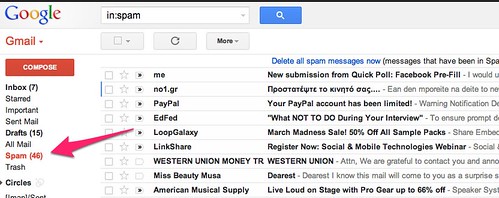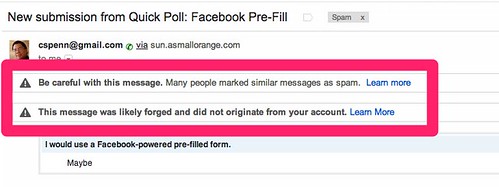Google’s Gmail service now gives you some warning as to why an email is flagged for spam. If your newsletters are being trapped by Gmail spam filters, you might want to have a look and see what the reasons are. Here’s how. First, make sure your Gmail account is subscribed to your list. If your message is flagged for spam, go into your spam folder and find it.

Click on the message to see details about why it’s in your spam folder:

Gmail will list one of 8 different spam warnings:
- Why is this message in Spam? We’ve found that lots of messages from newsletter@no1.gr are spam.
- Why is this message in Spam? It’s similar to messages that were detected by our spam filters.
- Why is this message in Spam? It contains content that’s typically used in spam messages.
- This message was likely forged and did not originate from your account.
- This message may not have been sent by: cspenn@gmail.com
- Be careful with this message. Similar messages were used to steal people’s personal information. Unless you trust the sender, don’t click links or reply with personal information.
- Be careful with this message. Many people marked similar messages as spam.
- Be careful with this message. It might contain a virus or a malicious link.
Let’s take a brief look at what each might mean for your email marketing program.
Reputation Problems
These two messages indicate that you have a reputation problem – that a lot of people are marking your messages as spam:
- Be careful with this message. Many people marked similar messages as spam.
- Why is this message in Spam? We’ve found that lots of messages from newsletter@no1.gr are spam.
If your email marketing is flagged with either of these messages, your reputation is in the trash. You need to consider things like re-engagement campaigns, pruning your list of bad or non-responsive email accounts, and generally improving your reputation among subscribers. People might be flagging you for deceptive subject lines or your unsubscribe link is so buried that they just flag you as spam instead. Bottom line: you need to send more good email and less bad email. Crank up your value, remove bad subscribers, and dig in for the long term reputation recovery.
Authentication Problems
These two messages indicate there’s an authentication problem with your email service provider and your account.
- This message was likely forged and did not originate from your account.
- This message may not have been sent by: cspenn@gmail.com
There’s a good chance that your DNS records are not set up correctly and/or you’re not using Sender ID, SPF, and other common email authentication mechanisms to certify that you are who you say you are. Fix those, and your messages should stop getting flagged for these criteria over time.
Content Problems
These two messages indicate that you’ve got a content problem.
- Why is this message in Spam? It’s similar to messages that were detected by our spam filters.
- Why is this message in Spam? It contains content that’s typically used in spam messages.
Your content has problems. It’s been judged not valuable or contains content that is such a hard sell that it triggers Google’s content-based filters. Things like all-image emails or overuse of sales promotional words and phrases are to blame here, so make sure there’s legitimate editorial content in your messages to balance out the sales pitches. Bottom line: send more valuable email, email that people actually want, and they’ll stop flagging it as spam. Make sure you have prominent unsubscribe links and use the List-Unsubscribe header option if your email service provider offers it so that people who don’t want to be on your list can leave instead of flagging you as spam.
Serious Content Problems
These two messages shouldn’t be seen with your email marketing.
- Be careful with this message. It might contain a virus or a malicious link.
- Be careful with this message. Similar messages were used to steal people’s personal information. Unless you trust the sender, don’t click links or reply with personal information.
Generally, these are reserved for messages that are phishing scams. If your email marketing is being flagged as spam with either of these two messages, you have a serious problem. Chances are, someone has hacked into your server or account on your email service provider (a case for strong passwords) and is sending scam emails from it. Contact your IT administrator or email service provider account manager immediately to get help.
If you don’t already have one, consider setting up a free GMail account and subscribing to your own newsletters just to get access to these kinds of spam reporting mechanisms. GMail is one of the first email services that offers this level of transparency about why a message is spam to the end user, which is immensely helpful to you as an email marketer.
For NetGains customers using our Professional, Broadcaster, or Publicaster editions, contact your account manager if you have questions about implementing any of the solutions discussed in this article. We’re happy to help. If you’re not a NetGains customer but would like to be to get access to a dedicated account manager who can help solve problems like these,
No comments:
Post a Comment